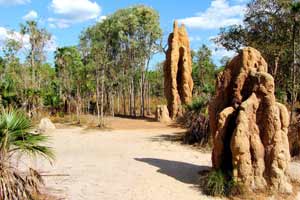
Darwin is famous for being the closest city to the Australian outback, with its massive population of saltwater crocodiles in the surrounding areas and as a gateway to the Kakadu National Park. The latter would be too big to explore in a day, so we have started with the smaller and easier to access
Litchfield National Park. With lots to do over a 1500sq km of land, this park is the locals’ favourite. Take a refreshing dip in one of waterfalls and waterholes, hire a 4x4 and explore one of the four-wheel drive tracks, take some snaps from the Tolmer Falls viewing point, visit the famous “graveyard” of magnetic termite mounds, some of them 2 metres tall, keep your eyes peeled for the enormous variety of fauna that can be seen here – wallabies, sugar gliders, quolls, flying foxes, dragon-like water monitors and an array of birds.
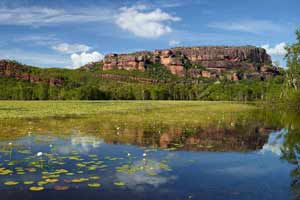
In case you have more time to dedicate to Kakadu National Park – don’t miss the most outstanding examples of Aboriginal rock art at Nourlangie and Ubirr. See about a third of Australia’s bird species at Yellow Water. Take a plunge at the Gunlom plunge pool – made famous in the 1986 film “Crocodile Dundee”. Take a scenic flight to see 200-metres high Jim Jam Falls and Twin Falls. Go for a walk in the Bush on one of the 30 established walking trails, some of them guided by park rangers. See more birds at the best bird-watch spots in Kakadu at the Mamukala wetlands.
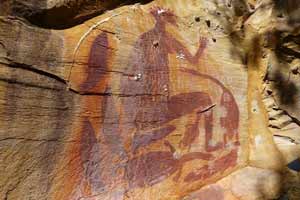 Nitmiluk National Park is next on our list, surrounding 13 magnificent gorges carved in the ancient sandstone by Katherine River as well some some prime examples of ancient Aboriginal rock art. Visit Tiwi Islands – the islands of smiles – an off-beaten path destination to meet the locals, almost 90% of whom are of Aboriginal descent with their art, excellent fishing and love of football. At the Territory Wildlife Park and the adjacent Berry Springs Nature Park see the animals and plants of the Top End through treetop aviaries, natural lagoons and nature walks. Mary River Wetlands are a home to the largest concentration of salt-water crocodiles in the world– many of the 100,000 estimated to live in Australia, are to be found here. Take a soak in one of the thermal pools at Tjuwaliyn/ Douglas Hot Springs – but don’t forget to check the temperature first!
Nitmiluk National Park is next on our list, surrounding 13 magnificent gorges carved in the ancient sandstone by Katherine River as well some some prime examples of ancient Aboriginal rock art. Visit Tiwi Islands – the islands of smiles – an off-beaten path destination to meet the locals, almost 90% of whom are of Aboriginal descent with their art, excellent fishing and love of football. At the Territory Wildlife Park and the adjacent Berry Springs Nature Park see the animals and plants of the Top End through treetop aviaries, natural lagoons and nature walks. Mary River Wetlands are a home to the largest concentration of salt-water crocodiles in the world– many of the 100,000 estimated to live in Australia, are to be found here. Take a soak in one of the thermal pools at Tjuwaliyn/ Douglas Hot Springs – but don’t forget to check the temperature first!
There is a number of sites in the city, dedicated to Darwin’s role in the Wold War II. The Darwin Military Museum is the oldest military history museum in the city and it displays a range of military artefacts, uniforms, photographs, weaponry, propaganda pieces, vehicles and artillery pieces, telling the story of all conflicts where Australian troops were involved. 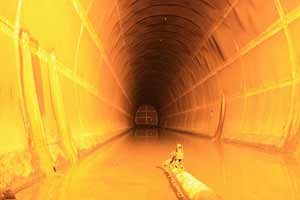 But the star of the show is the Defence of Darwin Experience – an immersive, interactive experience about the drama of the Japanese bombings on 19th Feb 1942. The Museum is situated at East Point Reserve where you can also swim year-round at saltwater Lake Alexander, walk, cycle or just have a picnic and relax in the green space.
But the star of the show is the Defence of Darwin Experience – an immersive, interactive experience about the drama of the Japanese bombings on 19th Feb 1942. The Museum is situated at East Point Reserve where you can also swim year-round at saltwater Lake Alexander, walk, cycle or just have a picnic and relax in the green space.
The Royal Flying Doctor Service Darwin Tourist Facility, called RFDS by the locals, reveals the tail of the birth and growth of the RFDS and its pilots, engineers, doctors, nurses and patients. The WWII Storage Tunnels are a unique tourist attraction, constructed during the war to protect the oil supplies of the city from the Japanese, and now housing a collection of photographs of Allied wartime activities. The Darwin Aviation Museum is where you can see an impressive collection of aviation artefacts, including one of the airplanes that Darwin was bombed by in WWII, documentation and relics related to the WWII aircraft crash sites and the defence of Darwin.
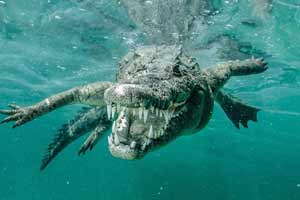 Crocodile interaction must be on your list when you visit Darwin. The adrenaline junkies can try the “Cage of Death” where an acrylic box is submerged into the living quarters of a large 18-foot saltwater crocodile at Crocosaurus Cove Park – an attraction/zoo facility that hosts over 70 species of reptiles from the Northern Territory’s Top End, Kimberley Region and Australia’s Red Centre. Crocodylus Park & Zoo is a more natural experience, yet very close to the city, where you can come face to face with the largest reptiles in the planet in their natural habitat. Feed an adult croc and hold a baby one, encounter playful meerkats, monkeys, tortoises, chameleons and blue-tongue lizards. Feed some of the big cats – the tigers and lions are fed outside of their enclosure, in a completely safe manner.
Crocodile interaction must be on your list when you visit Darwin. The adrenaline junkies can try the “Cage of Death” where an acrylic box is submerged into the living quarters of a large 18-foot saltwater crocodile at Crocosaurus Cove Park – an attraction/zoo facility that hosts over 70 species of reptiles from the Northern Territory’s Top End, Kimberley Region and Australia’s Red Centre. Crocodylus Park & Zoo is a more natural experience, yet very close to the city, where you can come face to face with the largest reptiles in the planet in their natural habitat. Feed an adult croc and hold a baby one, encounter playful meerkats, monkeys, tortoises, chameleons and blue-tongue lizards. Feed some of the big cats – the tigers and lions are fed outside of their enclosure, in a completely safe manner.
There are more interesting museums and galleries to see in Darwin, time permitting. 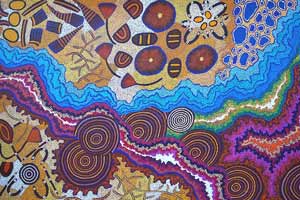 Head over to the unique Fannie Bay Gaol – a former prison, now a museum, and discover the stories behind this historic site that operated for nearly 100 years. The Chinese Museum is a small museum that explores the history of Chinese people that settled in the Northernmost section of the Northern territory from 1874 to the present day. The temple next door is Chung Wah Temple, opened in 1887 and a home to a sacred tree, thought to be a direct descendant from the Bodhi tree where Buddha sat under when he got enlightenment. The Museum and Art Gallery of the Northern Territory is the largest facility of its kind in the Northern Territory, a home to artistic, cultural and scientific collections and research programs, opened since 1981 and welcoming over 300,000 visitors each year. It presents Aboriginal culture, natural sciences, history and art focusing on Northern and Central Australia. A few more galleries sell Contemporary and Aboriginal, highly collectible art, such as Aboriginal Bush Traders, Nomad Art Gallery, Outstation Gallery and Mbantua Fine Art Gallery.
Head over to the unique Fannie Bay Gaol – a former prison, now a museum, and discover the stories behind this historic site that operated for nearly 100 years. The Chinese Museum is a small museum that explores the history of Chinese people that settled in the Northernmost section of the Northern territory from 1874 to the present day. The temple next door is Chung Wah Temple, opened in 1887 and a home to a sacred tree, thought to be a direct descendant from the Bodhi tree where Buddha sat under when he got enlightenment. The Museum and Art Gallery of the Northern Territory is the largest facility of its kind in the Northern Territory, a home to artistic, cultural and scientific collections and research programs, opened since 1981 and welcoming over 300,000 visitors each year. It presents Aboriginal culture, natural sciences, history and art focusing on Northern and Central Australia. A few more galleries sell Contemporary and Aboriginal, highly collectible art, such as Aboriginal Bush Traders, Nomad Art Gallery, Outstation Gallery and Mbantua Fine Art Gallery.